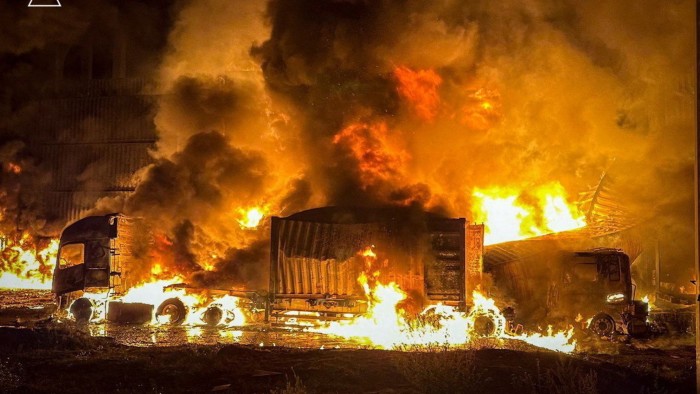Stay informed with free updates
Simply sign up to the War in Ukraine myFT Digest — delivered directly to your inbox.
A series of massive Russian air strikes in the past week has disabled nearly 60 per cent of Ukraine’s gas production, raising fears of winter shortages, according to two Ukrainian officials with knowledge of the damage.
The attacks prompted Ukrainian officials this week to call meetings with western partners to inform them of the situation, the officials told the Financial Times.
Russia fired another 450 drones and 30 missiles at Ukraine’s energy infrastructure in the early hours of Friday, cutting power in nine regions of the country, including Kyiv.
Sergii Koretskyi, chief executive of Naftogaz, Ukraine’s state energy company, said in an interview that Russia was again seeking to sap morale with targeted strikes on energy infrastructure, as it has every year since 2022. The difference this time, Koretskyi said, was in the frequency and scale of the attacks — with hundreds of drones and dozens of missiles on an almost nightly basis.
The Kremlin’s goal is “to break our spirit”, he said. “This has nothing to do with military needs, none of these assets have any military value at all.”
As a consequence of these attacks, “we need billions of cubic metres of gas more during the heating season”, he added.
Ukraine needed 13.2bn cubic metres of gas for the winter before the October attacks, and Kyiv had planned to import 4.6 bcm of gas by November 1 — “significantly more than in previous years”, Koretskyi said.
He declined to provide a specific number but the two Ukrainian officials predicted that at the current pace of Russia’s attacks, Ukraine would probably need to buy about 4.4 bcm more gas before March, or a fifth of the country’s annual use, at a cost of about $2.2bn.
President Volodymyr Zelenskyy told reporters on Wednesday that Russian forces had struck energy-related targets in Ukraine’s north-eastern Chernihiv, Sumy and Poltava regions 160 times over the past month.
He called Friday’s attack “cynical and calculated” and said it was “precisely the civilian and energy infrastructure that is the main target of Russia’s strikes ahead of the heating season”.
An October 3 attack on facilities in the Kharkiv and Poltava regions was described by Koretskyi as “the most massive and the most aggressive attack since the full-scale invasion started”. He earlier said that a “significant portion” of Naftogaz infrastructure was damaged in the assault, with “some of the destruction” described as critical. A second massive attack on gas infrastructure followed on Sunday, targeting gas storage facilities.
Maxim Timchenko, chief executive of DTEK, Ukraine’s largest private energy company, told the FT that “our assets are being attacked every day. Every day they damage some piece of equipment.”
His office said Friday’s assault was the third strike on its facilities in the past week. “Since February 2022, our thermal power stations have been hit over 200 times”, a DTEK statement said.
Koretskyi said that he, along with the government of Ukraine, had spoken with G7 ambassadors about the country’s needs over the winter. Kyiv has previously relied on foreign technical assistance and equipment to patch critical energy systems following attacks. But much more is needed as Russia’s bombardments intensify.
Koretskyi said Kyiv was in dire need of “more air defence systems”.
Russia’s drone strikes are “becoming more massive, more precise and definitely they are using AI”, Timchenko said. “If they select a target and send 50, 60, 100 drones and missiles then it’s very difficult for our air defence to protect these facilities.”
DTEK had done what it could to protect low- and medium-voltage substations with concrete walls or sandbags, he said.
Recommended
Koretskyi said that Naftogaz had done the same at its facilities. He showed the FT photographs of extensive defensive structures made of concrete and sand standing several metres high around its facilities.
“But of course it all depends on how many pieces of air defence equipment they [Ukraine’s air defence forces] have and, more importantly, whether they have ammunition,” Timchenko said.
Another crucial need, Koretskyi said, was additional equipment for repairs, including compressors and power transformers. Kyiv’s goal, said Koretskyi, was to create “a strategic reserve of this equipment”.
For its part, DTEK is investing heavily in onshore wind farms and battery storage to help build a more resilient power grid. “For us, decentralised dispersed power generation is the best way to minimise the success of Russian attacks,” said Timchenko.


